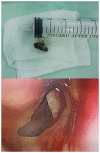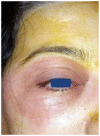Current diagnosis and treatment of rhinosinusal aspergilloma (Review)
- PMID: 34603532
- PMCID: PMC8453335
- DOI: 10.3892/etm.2021.10699
Current diagnosis and treatment of rhinosinusal aspergilloma (Review)
Abstract
There are numerous types of sinusitis caused by fungal strains, some of which already colonize the nasal cavity. Mild forms present fungus balls growing inside a preexisting sinus cavity. The invasive type ranges from chronic manifestations to acute aggravated episodes. The latter scenario is encountered in cases with reduced immune responses, such as patients with diabetes, individuals receiving any form of transplant, AIDS cases and chemotherapy patients. Without the control of immunosuppression, the infection is aggravated and extends to the orbit and inside the skull base, regardless of the prompt surgical and medical treatment. This is the most common pathogenic fungus on the nasal sinuses level. It can occasionally enter the sinus cavity during dental procedures. The pathogenesis is enhanced by anaerobic conditions in poorly ventilated sinus cavities. Rhinosinusal aspergilloma has a slow, insidious evolution over months and even years. Our experience revealed the presence of both a dental problem and previous self-administered antibiotic regimens in almost every case. The initial symptoms are common with sinusitis of dental origin, but aspergilloma should be considered when a patient with a competent immune system does not respond to standard antibiotic treatment. The final diagnosis of rhinosinusal aspergilloma is conducted on a pathology sample with silver staining. The bacteriology exam of the sinus secretion rarely reveals a fungus infection; however, as revealed in our clinical experience, there may be coinfection with other multidrug-resistant bacteria. Surgical treatment must establish a wide exposure of the sinus cavity and correct drainage regardless of the external, combined or endoscopic approach. Early diagnosis and emergency surgical debridement along with administering systemic antifungal compounds in some cases represent the key to the successful treatment of invasive aspergilloma.
Keywords: aspergilloma; diagnosis; pathology; rhinosinusal; treatment.
Copyright: © Vrinceanu et al.
Conflict of interest statement
The authors declare that they have no competing interests.
Figures












References
-
- Neville BW, Damm DD, Allen CM, Bouquot JE. Fungal and protozoal diseases. In: Oral and Maxillofacial Pathology. 2nd edition. Saunders, Philadelphia PA, pp189-211, 2005.
Publication types
LinkOut - more resources
Full Text Sources
